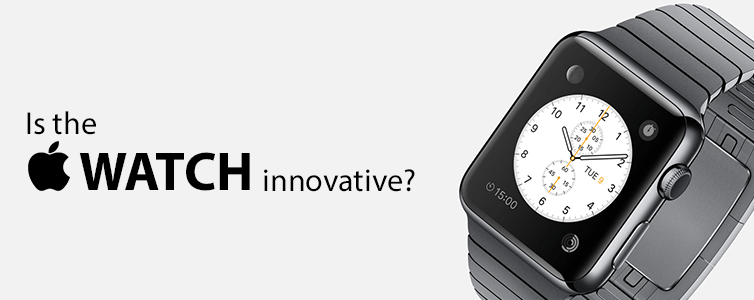Article
Is the Apple Watch Innovative?

This is what one of my friends asked me following the announcement of the Apple Watch. He suggested that the Apple watch didn’t really do anything new or different than other smart watches on the market, rather, they were just following the smart watch trend and coming out with their version.
Is he right?
My short answer: No, but let me explain in length…
To answer that question, let’s first look at the history of Apple product launches into new categories, starting with the iPod.
The iPod
The iPod was not the first MP3 player on the market. In fact, MP3 players had been out for a few years. So how was the iPod innovative?
It was innovative in three ways. First, the iPod worked with iTunes, a digital marketplace for downloading music and managing the music on your iPod. Before iTunes, digital music was usually ripped from cds or downloaded through services such as Napster. To manage the music on an MP3 player was inconvenient and required a little more technical prowess than the average user may have posessed. iTunes made managing music simple and easy.
Second, the iPod had more storage than other MP3 players. Remember the tagline, “a thousand songs in your pocket.”
Third, the iPod had a scroll wheel that made it easy to navigate the 1,000 songs in your pocket. This is one of the things that Apple does best: really thinking through the user experience and coming up with innovative ways to make the experience intuitive and easy.
The iPhone
Next, Apple launched the iPhone. Again, the iPhone was not the first smartphone on the market. Palm was at its peak and Blackberries were the popular choice of business people when the iPhone launched. So how was the iPhone innovative?
It was innovative in two ways. First, Apple completely rethought the user experience. By introducing gesture recognition, which they call Multi-Touch, Apple was able to create a whole new operating system based on touch. This proved to be a far better way to interact with a small digital device than a stylus or scroll wheel.
Second, Apple introduced the App Store with third party apps. Not only that, but Apple created an App development environment that made it relatively easy for developers to create and launch iPhone apps, creating an entirely new industry in the process.
The iPad
Then Apple launched the iPad, which was highly criticized at its launch as being just a big iPhone. Then it went on to be one of the most successful product launches of all time, selling two million iPads in less than 60
days. So how was the iPad innovative? Because the iPad is pretty much just a big iPhone it was innovative for the same reasons, but for a new product category. Before the iPad was launched, netbooks were the tech industry’s best idea for a highly portable internet connected computers. Netbooks were basically just scaled down and miniaturized laptops. They were slow and didn’t really do anything novel. The large Multi-Touch screen, intuitive UI, portability, fast performance, and long battery life is what made the iPad innovative.
The Apple Watch
So, does the Apple Watch follow the same pattern of being innovative like the iPod, iPhone and iPad were? Yes, I believe it does. So, how is the Apple Watch innovative?
First, Apple did what they did with the iPod and iPhone: thought about how to deliver the best user experience. What Apple didn’t do was miniaturize the iPhone experience for the Apple Watch. Not only is the Apple Watch a touch screen, Apple created a ‘digital crown’ that allows for nimble and precise zooming and scrolling without obstructing the view. The digital crown also doubles as a familiar home button. Apple also introduced a new touch sensitivity feature that can tell the difference between a tap and a press, allowing for “instant access to a range of contextually specific controls – such as an action menu in Message, or a mode that allows you to select different watch faces – whenever you want it.” That’s not all; Apple also added haptic feedback, which in non-technical jargon means that it taps you on the wrist. This isn’t just a simple vibrate function. As Apple describes it, “Whenever you receive an alert or notification, or perform a function like turning the Digital Crown or pressing down on the display, you feel a tactile sensation that’s recognizably different for each kind of interaction.”
Second, Apple put an accelerometer and heart rate monitor on the Apple Watch. While including such sensors is no different than competing android Wear devices, the implementation is expected to be more successful. Combined with the GPS, Wi-fi, and altimeter (iPhone 6) on the iPhone, these sensors track your movement throughout the day. With Apple’s Activity App the Apple Watch shows you how much you are moving, exercising, and standing throughout the day and suggest goals for doing each of those things. Additionally, the Apple Watch has it’s own Workout App to track cardio workouts with more detailed measurements, such as time, distance, calories, and pace. Both these apps sync with the Health App for iPhone to give you an overall picture of your Health. The health and fitness market is a huge industry that is ripe for disruption in the wearable device space. The Apple Watch is a likely Fitbit, Nike FuelBand, and GPS watch killer.
Third, with Apple’s announcement of WatchKit, the developer SDK for creating third-party apps, the Apple Watch becomes a new platform that makes it easy to create great apps that work with a high quality wearable device that millions of people will soon have. Apple already has an enormous developer community, 9 million or so as I write this, who will be chomping at the bit to create apps for the Apple Watch.
Finally, Apple created a beautiful range of Apple Watch products to appeal to different tastes, styles, and scenarios. Unlike a computer that goes on your desk, or an iPhone that goes in your pocket, the Apple Watch is worn on the wrist where it makes a fashion statement about the person wearing it. No other smartwatch on the market has offered even close to the range of styles that the Apple Watch will be offered in at launch. There are two sizes: 38mm and 42 mm. Three lines: the Apple Watch, Apple Watch Sport, and Apple Watch Edition. Two case colors in each line: stainless steel or black stainless steel, silver aluminum or space grey aluminum, 18-karat rose gold or 18-karat yellow gold. On top of that there are 20 or more interchangeable watch bands (bracelets). Who wouldn’t want choose from 140 different options compared to 6 for Google’s Android Wear smart watches?
Of course, time (pun intended) will tell how successful the Apple Watch will really be. Perhaps my friend was right and Apple is just following the crowd and will only be mildly successful. But based on Apple’s history where similar doubtful remarks were made at the inception of their product launches, and Apple’s respected leadership with worldwide product trust, I predict that the Apple Watch will be a huge success!
To summarize, I believe the Apple Watch follows the same pattern of innovation that Apple used with the iPod, iPhone, and iPad and is primed to be Apple’s next big hit–a game changer in the smart watch and wearable device industry.
With the capabilities of the Apple Watch revealed and its impending successful launch early next year, let us know if we can help you develop an Apple Watch app for your business.








